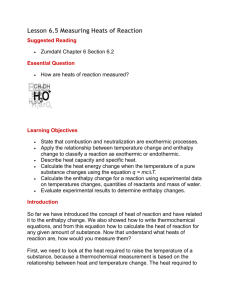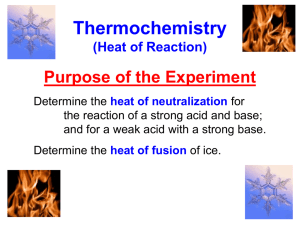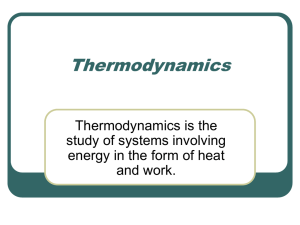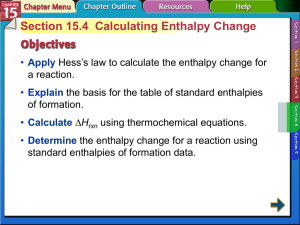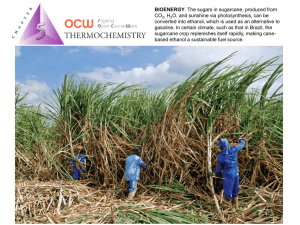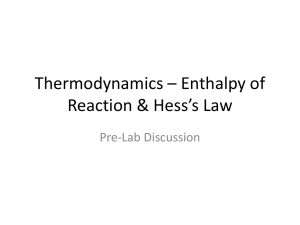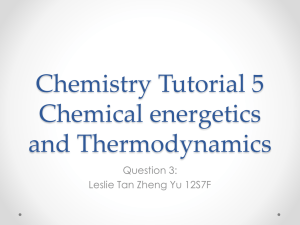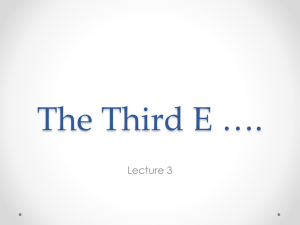Chapter 5 – Thermochemistry
advertisement
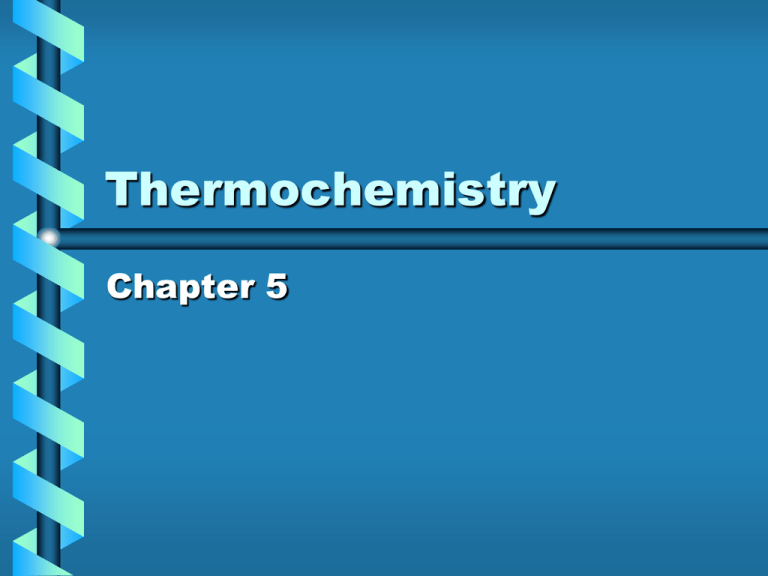
Thermochemistry Chapter 5 First Law of Thermodynamics • states that energy is conserved • Energy that is lost by a system must be gained by the surroundings or vice versa. Enthalpy (H) • accounts for heat flow in chemical changes occurring at constant pressure Enthalpy (H) • State function: • H=Hfinal-Hinitial Enthalpy (H) • When DH > 0, the system has gained heat from surroundings (endothermic) • When DH < 0, the system has released heat to the surroundings (exothermic) Enthalpy (H) Enthalpies of Reaction • Thermochemical equations are balanced chemical equations that show the associated enthalpy change Enthalpies of Reaction • DH = H(products) – H(reactants) Guidelines • (1)H is an extensive property meaning it depends on the amount of reactant consumed in the process Guidelines • (2) The DH for a reaction is equal in magnitude, but opposite in sign, to the reverse reaction Guidelines • (2) Guidelines • (3) The DH for a reaction depends on the state of the reactants and products and we assume they are at constant T Practice 5.5 • How much heat is released when 4.50 g of methane gas is burned in a constant pressure system? • Given: • CH4(g) + 2O2(g) CO2(g) +2H2O(l) DH = -890kJ Enthalpies of Reaction • DH can be determined experimentally by measuring the heat flow accompanying a reaction at constant pressure which is done by measuring Temperature changes Enthalpies of Reaction • Calorimetry is the measurement of heat flow • A calorimeter will measure this heat flow Heat Capacity • the amount of heat required to raise the temperature of an object by 1K or 1oC. Molar Heat Capacity • heat capacity of one mole of a substance Specific Heat Capacity • heat capacity of 1g of substance Specific Heat Capacity Enthalpies of Reaction • Heat = specific heat x grams of substance x DT • q=cm DT Sample Exercise 5.5 Relating Heat, Temperature Change, and Heat Capacity (a) How much heat is needed to warm 250 g of water (about 1 cup) from 22 °C (about room temperature) to near its boiling point, 98 °C? The specific heat of water is 4.18 J/g-K. (b) What is the molar heat capacity of water? Constant- Pressure Calorimetry Constant- Pressure Calorimetry • (1)Assume the calorimeter prevents loss or gain of heat from the solution to its surroundings Constant- Pressure Calorimetry • (2a) For an exothermic rxn, heat is lost by rxn and gained by soln so the T of soln rises Constant- Pressure Calorimetry • (2b) For an endothermic rxn, heat is gained by rxn and lost by soln so the T of soln goes down Constant- Pressure Calorimetry • (3) qsoln = specific heat of solution x gram of solution x DT = -qrxn Sample Exercise 5.6 Measuring ΔH Using a Coffee-Cup Calorimeter When a student mixes 50 mL of 1.0 M HCl and 50 mL of 1.0 M NaOH in a coffee-cup calorimeter, the temperature of the resultant solution increases from 21.0 °C to 27.5 °C. Calculate the enthalpy change for the reaction in kJ/mol HCl, assuming that the calorimeter loses only a negligible quantity of heat, that the total volume of the solution is 100 mL, that its density is 1.0 g/mL, and that its specific heat is 4.18 J/g-K. Bomb Calorimetry • Constant-Volume Calorimetry • Combustion reactions are studied in bomb calorimeters Bomb Calorimetry Bomb Calorimetry • The heat released in combustion is absorbed by the calorimeter contents, causing a rise in the temperature of the water Bomb Calorimetry • To calculate DH combustion from the measured temperature increase, we must know the heat capacity of the bomb calorimeter, Ccal Bomb Calorimetry • qrxn = -Ccal x DT Sample Exercise 5.7 Measuring qrxn Using a Bomb Calorimeter • Methylhydrazine (CH6N2) is used as a liquid rocket fuel. The combustion of methylhydrazine with oxygen produces N2(g), CO2(g), and H2O(l): • • 2 CH6N2(l) + 5 O2(g) → 2 N2(g) + 2 CO2(g) + 6 H2O(l) • When 4.00 g of methylhydrazine is combusted in a bomb calorimeter, the temperature of the calorimeter increases from 25.00 °C to 39.50 °C. In a separate experiment the heat capacity of the calorimeter is measured to be 7.794 kJ/°C. Calculate the heat of reaction for the combustion of a mole of CH6N2. Hess’ Law • If a reaction is carried out in a series of steps, DHrxn will equal the sum of DH for the individual steps. DHrxn = DH1 + DH2 + … Hess’ Law • Hess’ law provides ways to calculate energy changes that are difficult to measure directly. Sample Exercise 5.8 Using Hess’s Law to Calculate ΔH Hess’ Law Hess’ Law (5.9) se Hess’ Law (5.9) Standard enthalpy of a reaction • is the enthalpy change when all reactants and products are in their standard states, o DH rxn Standard States • Standard state is when a substance is in its pure form at 1 atm and 298K. Standard enthalpy of formation DHof,, reported in kj/mol, is the change in enthalpy for the reaction that forms 1 mole of the compound from its elements, with all substances in their standard state. Standard enthalpy of a formation • DHfo of the most stable form of an element is zero because there is no formation reaction needed for an element in its standard state. Standard enthalpy of a formation • Standard enthalpy of a formation (5.10) • Enthalpy of Reaction • DHorxn = S n DHof (products) - S m DHof (reactants) , where n and m are the coefficients in the balanced chemical equation 5.11 Enthalpy of Reaction • Calculate the standard enthalpy change for the combustion of 1 mol of benzene(l), to form CO2(g) and H2O(l). 5.12 Enthalpy of Reaction • The standard enthalpy change for the decomposition reaction of CaCO3 is 178.1 kJ. From the values for the standard enthalpies of formation of CaO(s) and CO2(g), calculate the standard enthalpy of formation of CaCO3(s).



